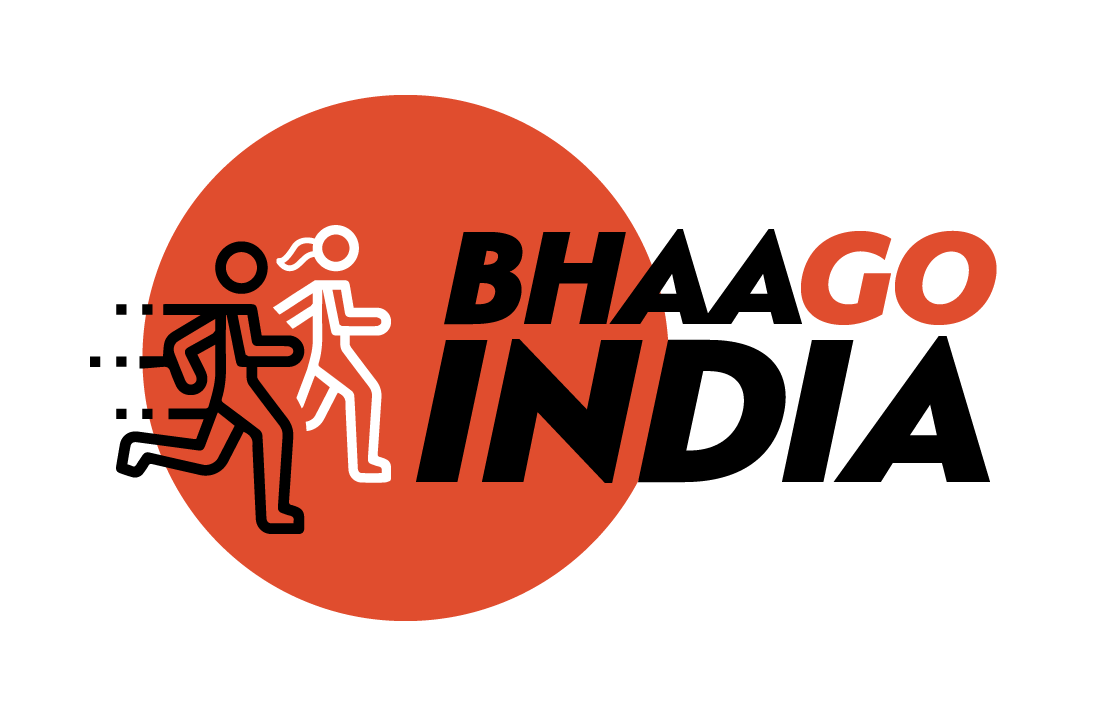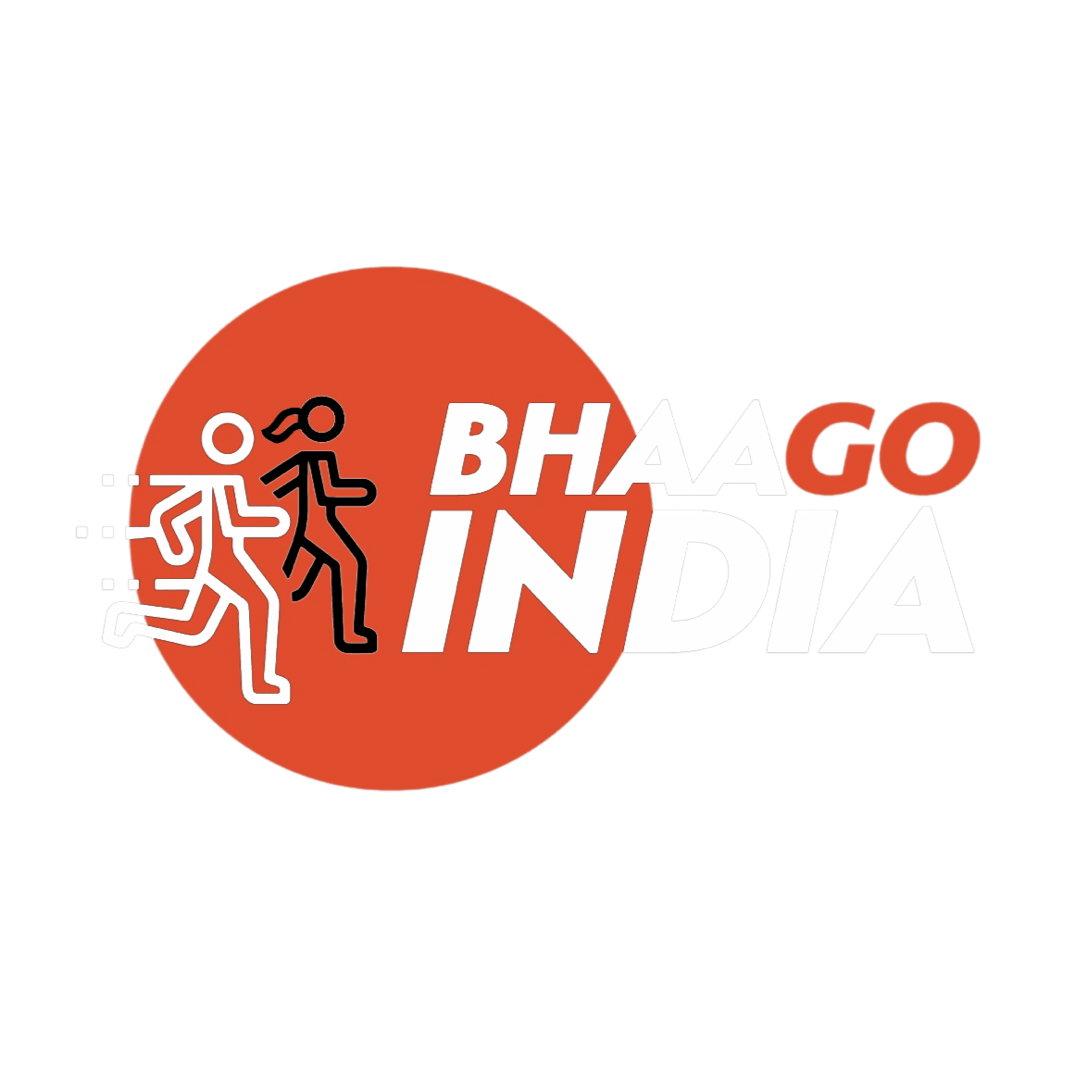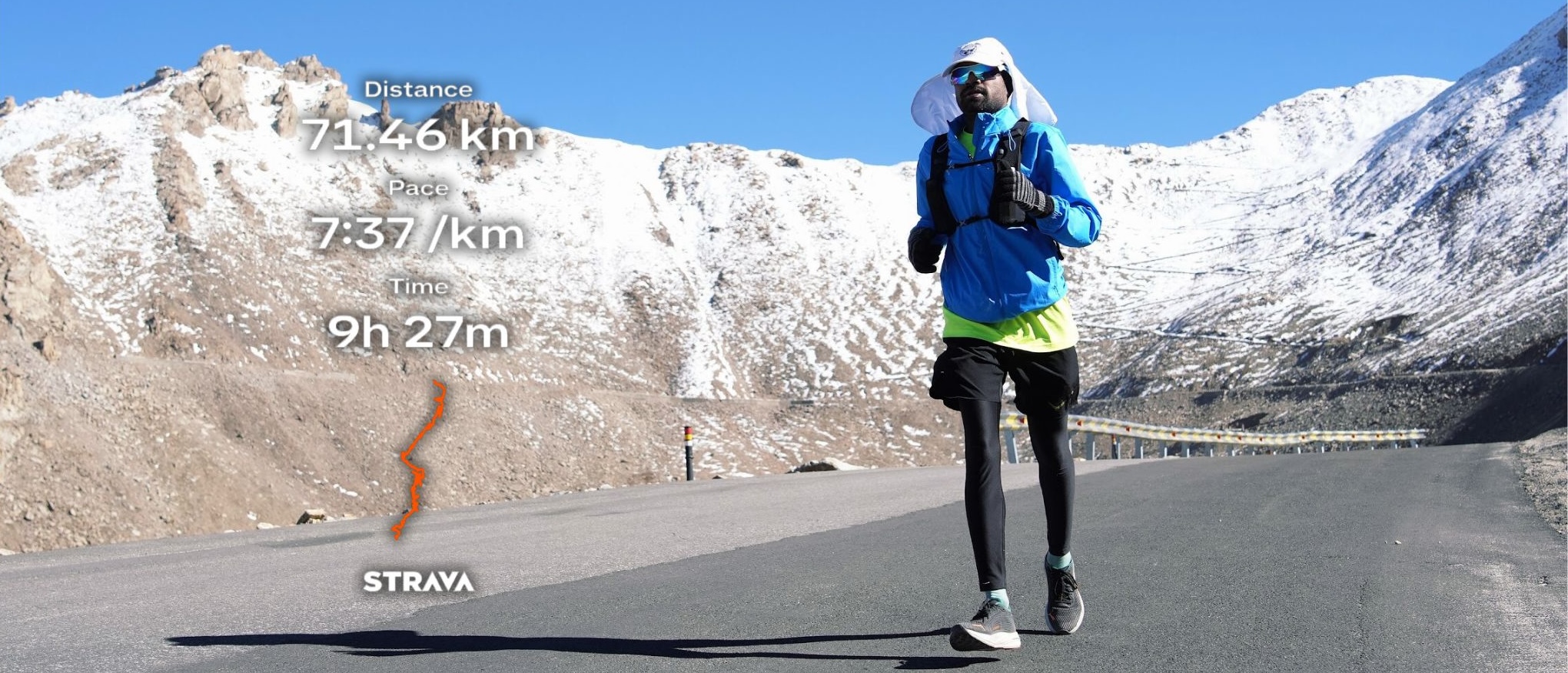The thin mountain air burns your lungs with every breath. At 17,618 feet, where the Himalayas scrape the sky, oxygen becomes a luxury your body can't afford. This is Khardung La Pass — one of the world's highest motorable roads and, for one September morning in 2025, my running route.
Seventy-two kilometers of unforgiving terrain stretched between Khardung village and Leh. First came the relentless climb through landscapes so barren they feel alien, where each step becomes a negotiation between ambition and physiology. Then the punishing descent — 40 kilometers that would test legs already pushed beyond their comfort zone, where gravity becomes both friend and enemy.
Most people drive this route, windows up, grateful for their vehicle's protection against the elements. I planned to run it with a field of 250+ other runners.
The inspiration struck a year earlier during my trip to Ladakh for the full marathon. Two days before my race, I stood at the finish line watching the Khardung La Challenge and Silk Route Ultra finishers cross into Leh. These runners looked different — hollowed out, transformed by something beyond the marathon distance I knew. Their distant, exhausted expressions and quiet satisfaction spoke of a realm I'd never entered. I felt equal parts fascination and fear.
I'd run marathons before, comfortable in that familiar 42.2-kilometer territory where I knew my body's responses, my pacing, my limits. But as I watched those ultra finishers, something stirred in me — the pull of the unknown, the hunger for a challenge that would redefine what I thought was possible. The Khardung La Challenge wasn't just longer than anything I'd attempted; it was my gateway into ultra-marathon territory, where running becomes as much about mental resilience as physical endurance.
After five months of methodical preparation, I felt as ready as someone from low altitude could be for what the Himalayas had in store. What followed taught me everything about pacing at altitude, the critical importance of acclimatization, and how the mind can push the body far beyond what seems possible.
Part 1: My Ultramarathon Training Plan
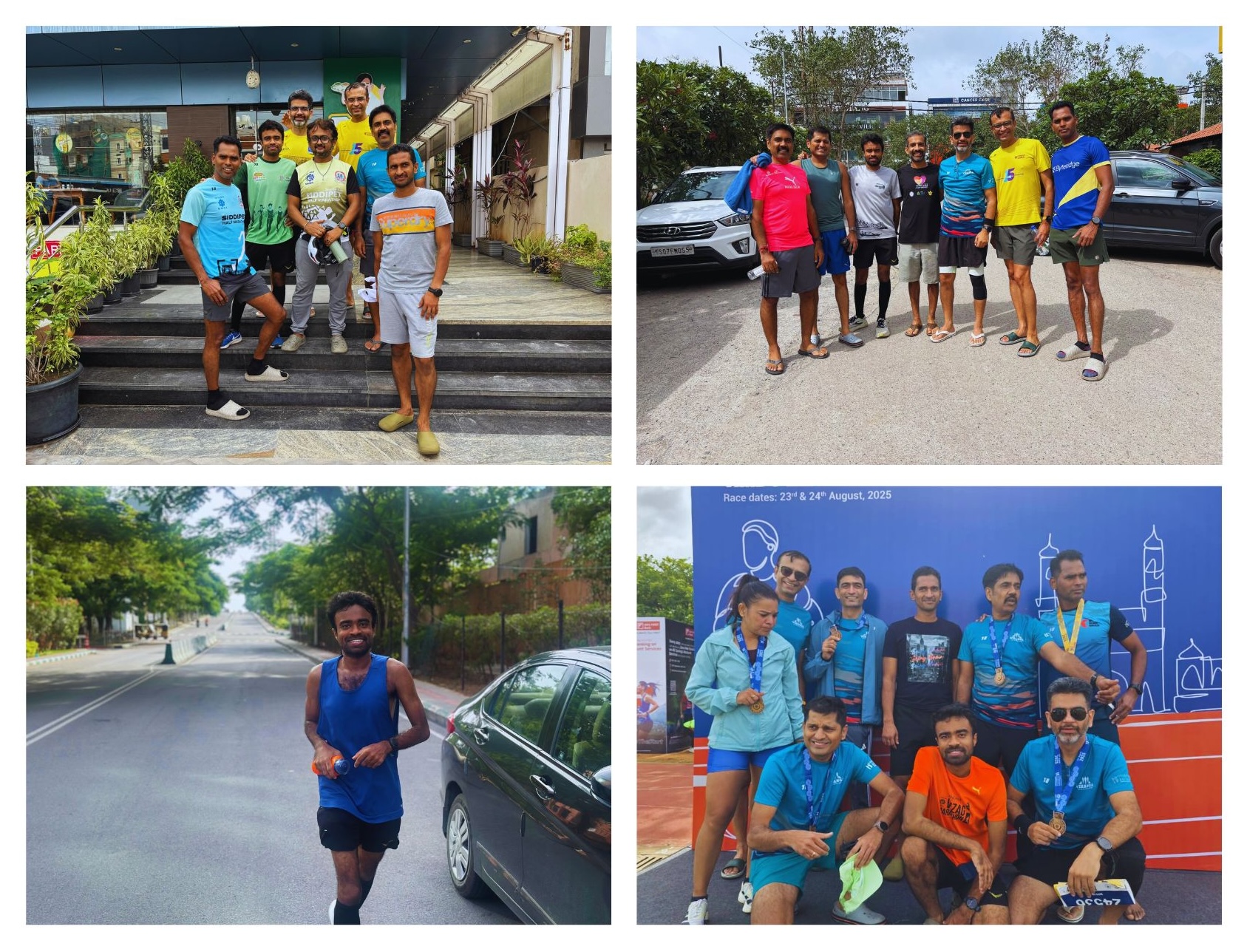
Preparing for my first ultra without a coach meant trusting my instincts and learning from every run. Over four months (mid-April to early August), I built a foundation of 100+ kilometer weeks, peaking at 135 km — all guided by intuition rather than a formal training plan.
Three key strategies emerged from this self-coached approach, and they might just work for your ultra prep too:
The Power of Group Long Runs
The magic happened on Sundays. Week after week, I joined fellow runners in Hyderabad for long runs that became the cornerstone of my preparation. There's something powerful about suffering together — when your legs scream at kilometer 35, having someone beside you makes the difference between stopping and pushing through.
We started conservatively at 30 km, progressed to 40 km (twice), and culminated with a 50 km effort. No heroics, no ego-driven jumps in distance. Just steady, sustainable progression that built confidence with each completed run.
Smart Distance Limits (Yes, 50km Was Enough)
I deliberately capped my longest training run at 50 kilometers. While some ultra runners chase 60-70 km training runs, I believed in building endurance without destroying my body. The goal wasn't to replicate race distance in training but to develop the aerobic base and mental resilience needed for the unknown territory beyond 50 km.
That 50km run wasn't about speed — I ran it at a comfortable, conversational pace, focusing on how my body responded to five hours of continuous movement. What would my energy levels feel like at hour four? How would my nutrition strategy hold up? Could I maintain good form when fatigue set in? These were the real questions I needed answered.
This approach kept me healthy, hungry, and curious about what lay beyond my longest training effort. Sometimes the best preparation is knowing when to stop preparing.
Self-Coaching: Listening to Your Body Over Rigid Plans
Without a coach dictating my training, I learned to listen carefully to my body, adjusting weekly mileage based on how I felt rather than following arbitrary numbers. The Sunday group runs became my laboratory — testing everything from hydration strategy to mental mantras for the tough kilometers.
Some weeks I ran 110 km, others 125 km. Bad sleep or work stress meant dialing back. Feeling strong meant pushing a bit harder. The key was consistency over perfection, adaptation over rigid adherence to a plan.
The Final Test
The final tune-up came at the NMDC Hyderabad Marathon on August 24th, where I clocked 3:20 — strong enough to confirm my fitness, controlled enough to avoid any lingering fatigue. This was my last long effort before tapering, a final systems check to ensure everything felt right.
With that confidence boost, I began tapering for Leh, ready to discover what lay beyond the 50-kilometer boundary I'd never crossed.
Key Ultra-Marathon Training Tips for High-Altitude Success:
Find a consistent group - Sunday long runs with others made the difference between quitting and pushing through tough kilometers
Cap your longest run sensibly - 50km was enough; focus on time on feet rather than replicating race distance
Run long runs at conversational pace - use them to test systems (nutrition, hydration, form) rather than speed
Listen to your body over rigid plans - adjust weekly mileage based on sleep, stress, and how you feel
Use a tune-up race - a final marathon 2-3 weeks before your ultra provides confidence without fatigue
Consistency beats perfection - steady weekly mileage matters more than hitting exact numbers
Part 2: Acclimatization Journey
Arrival: Rain and Reality Check
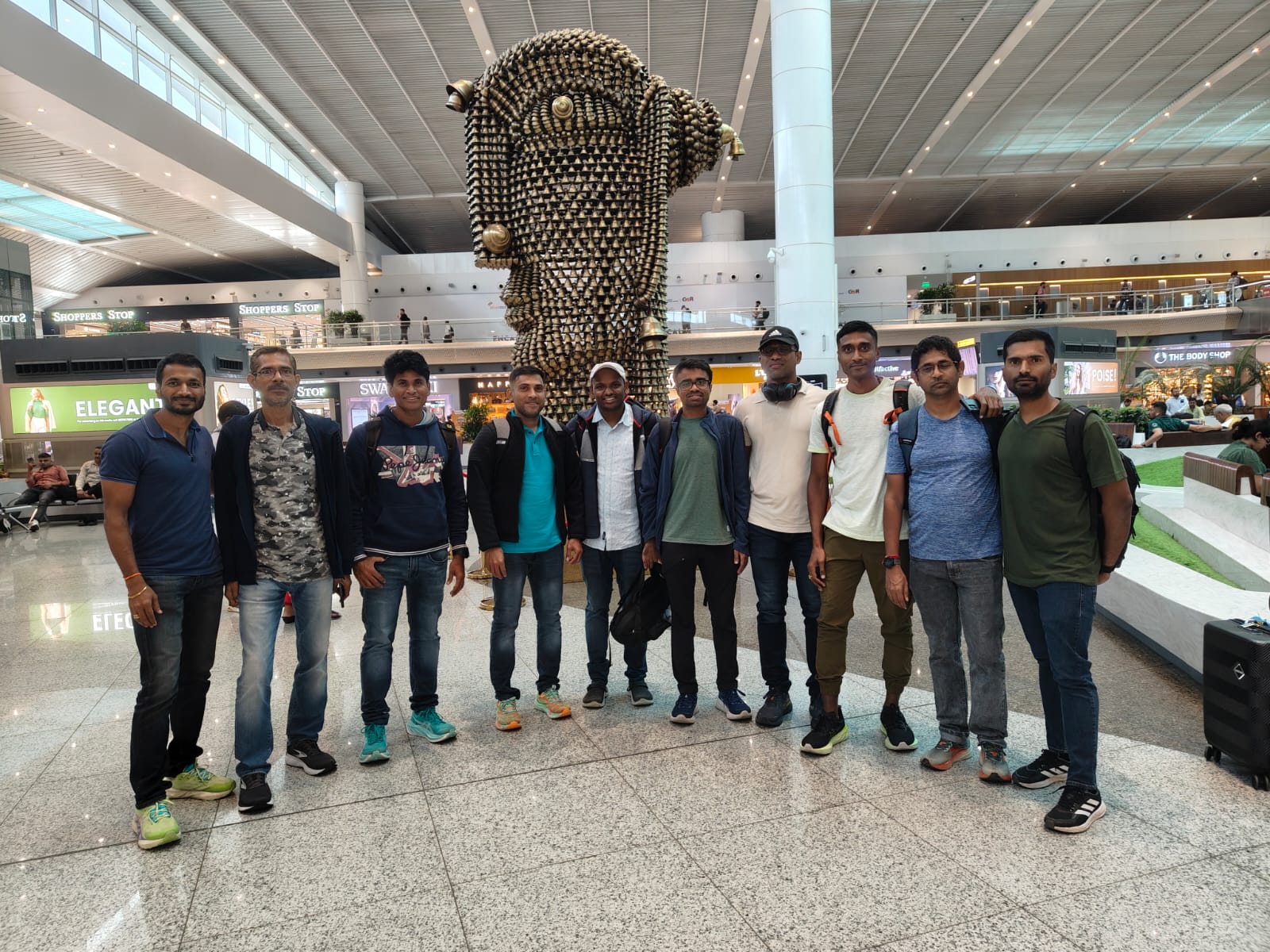
On August 31st, our crew of eight runners from Hyderabad touched down in Leh, with six of us preparing for the Khardung La Challenge and two for the Ladakh Full Marathon. Light rain greeted us at the airport, an ominous sign in a region known for its desert-like conditions. This year brought record rainfall to Ladakh, and whispers of potential race day complications followed us from the terminal.
The thin air hit immediately. At 11,500 feet, even walking felt different — your body constantly reminding you that oxygen was now a limited resource.
Settling In: The Art of Doing Nothing
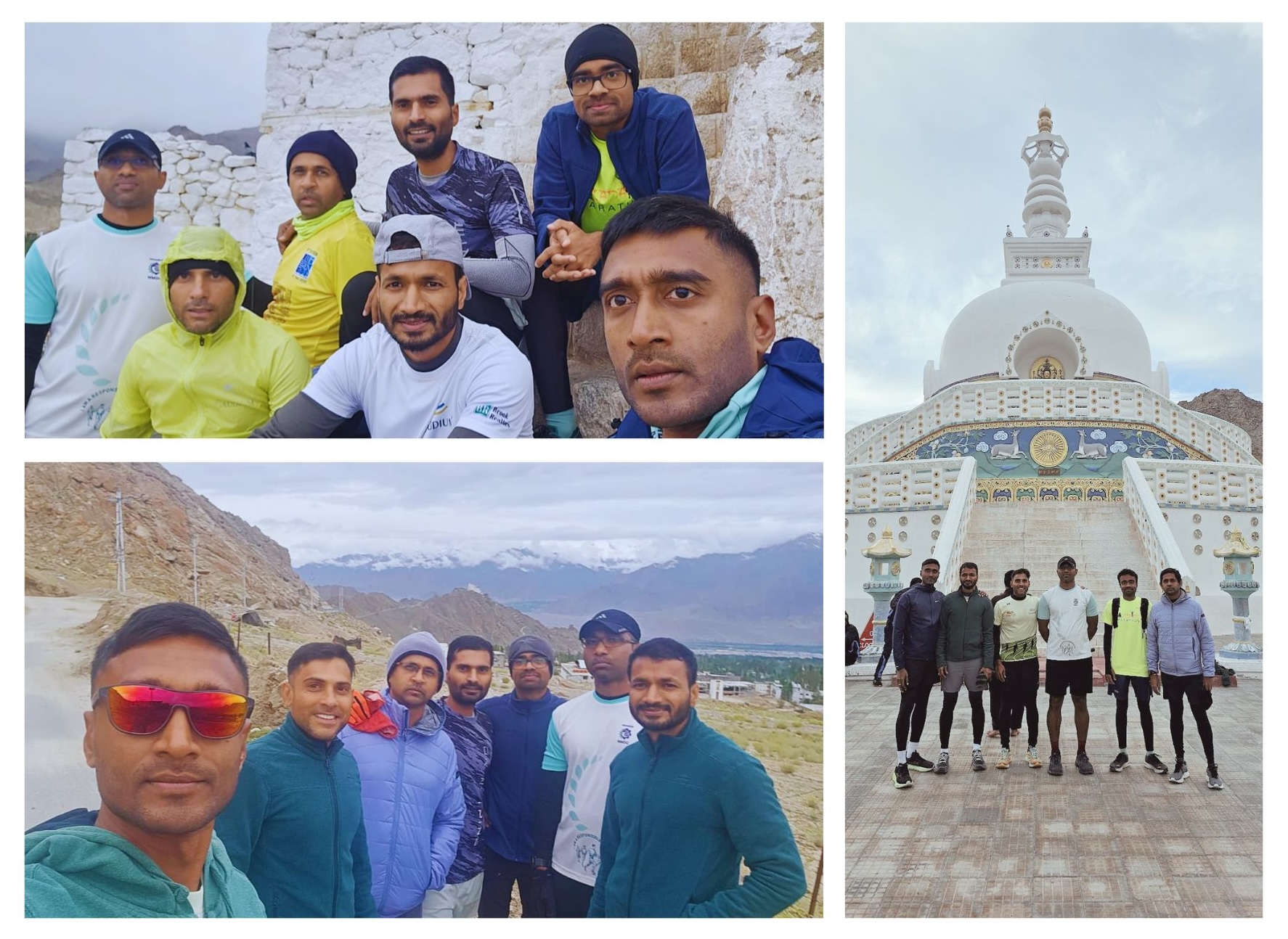
The first 2-3 days were about patience and humility. While every instinct screamed to test our fitness, we focused on rest and hydration. Light jogs to Shanti Stupa, gentle walks to the Old Castle — nothing that would stress our low-altitude-adapted bodies.
Our first proper run came on day four: a 12-kilometer out-and-back to Leh airport. Simple distance, but it felt like a small victory. The key was listening to our bodies and not pushing beyond what felt comfortable.
Bib Collection: Gear That Mattered
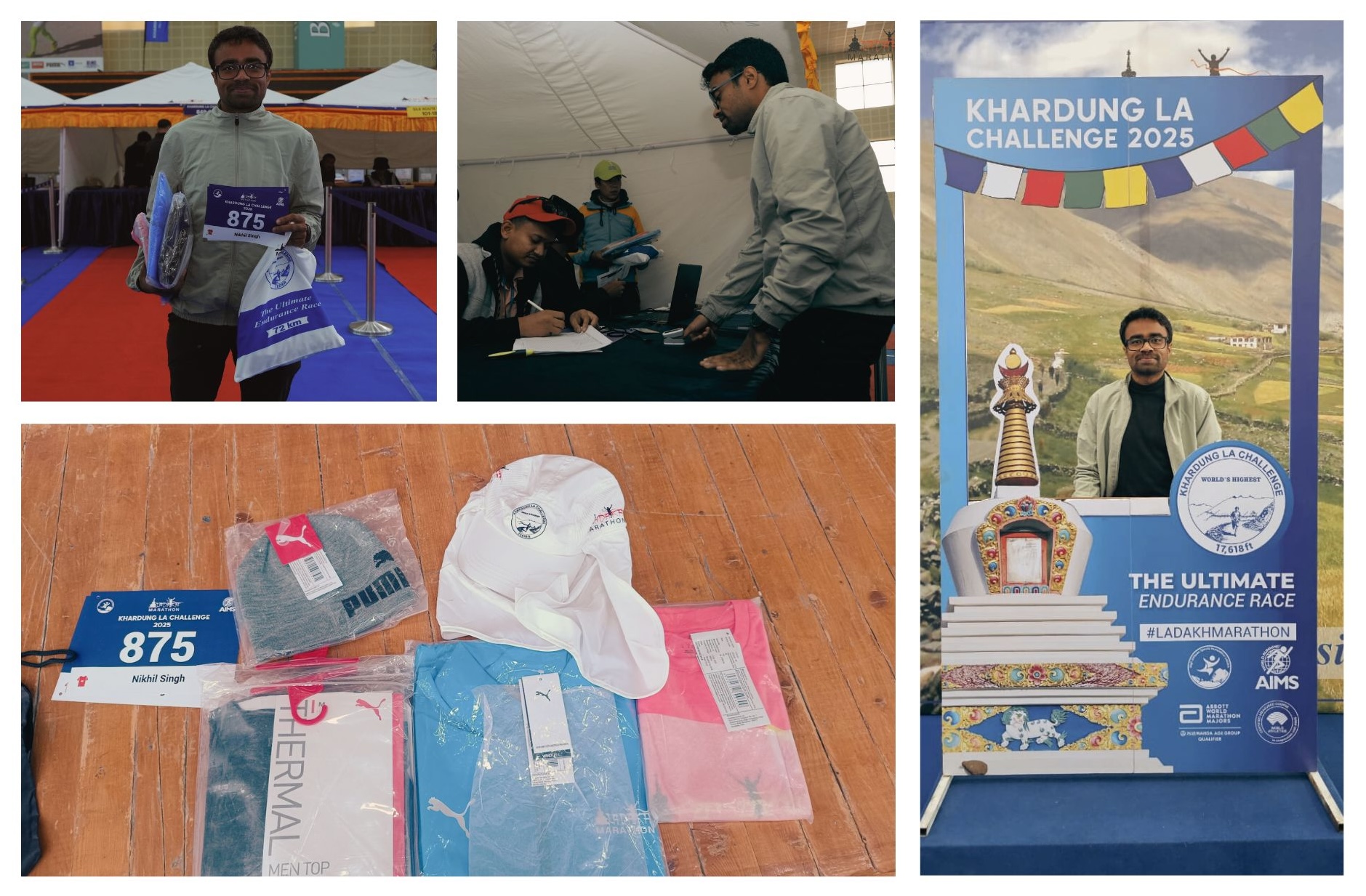
September 3rd brought bib collection and our first real glimpse of race organization. The Ladakh Marathon team impressed us with high-quality gear — running jacket, thermals, cap, and beanie that would prove invaluable when the Himalayas showed their teeth. Sometimes the difference between finishing and DNF comes down to having the right gear when conditions turn.
The Khardung La Dress Rehearsal
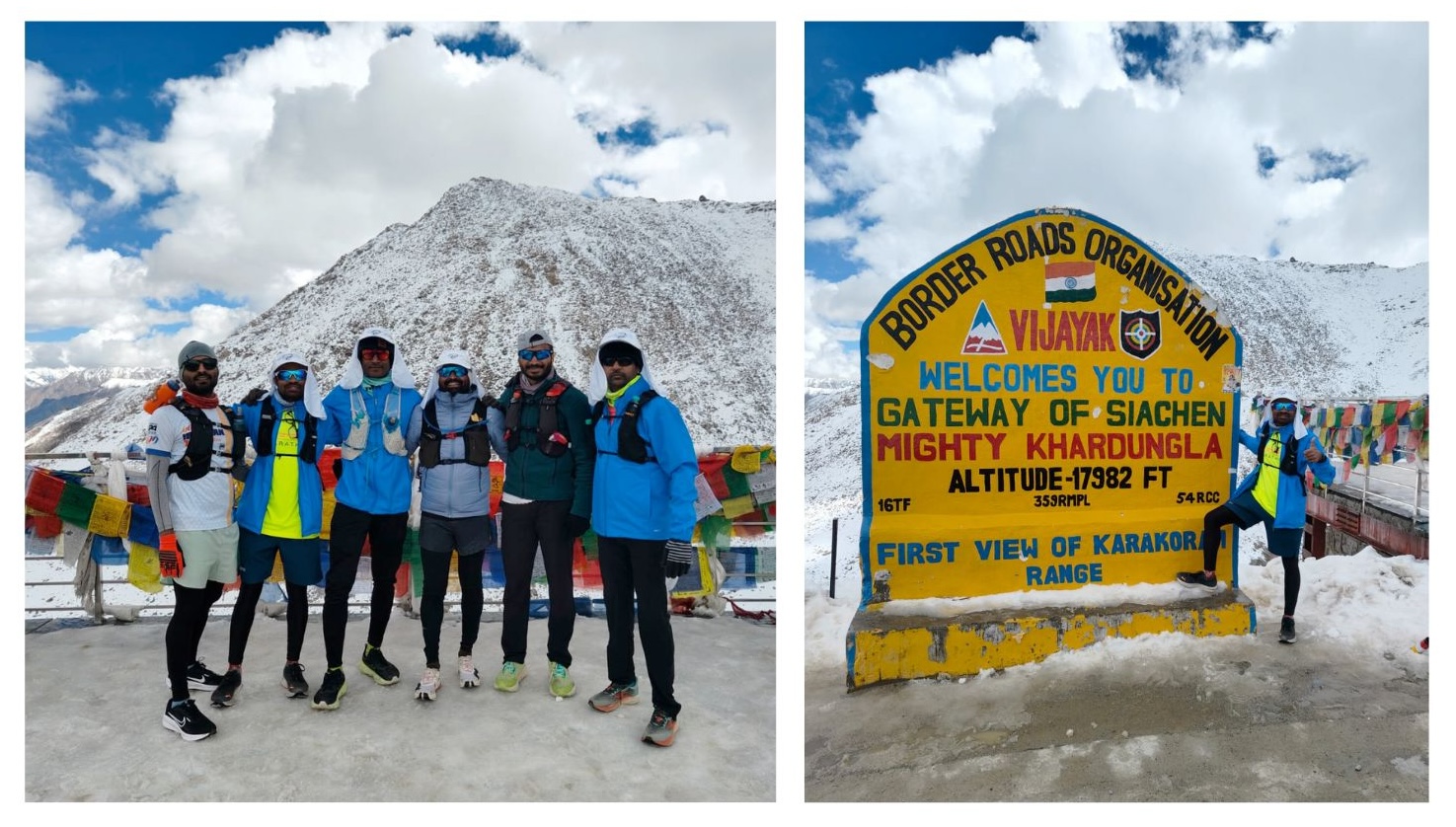
The most crucial lesson in our high-altitude acclimatization came during our demo run on Khardung La Pass. I decided to test myself with a half marathon — 10 kilometers uphill, 11 kilometers down. The climb felt manageable, almost enjoyable in the crisp mountain air.
Then came the descent. I pushed too hard on the downhill, letting gravity pull me into a pace that felt effortless but was actually punishing my system. By the bottom, I was battling a pounding headache and waves of nausea. The altitude had taught me a harsh lesson: descents at high altitude demand respect and controlled pacing, not reckless speed.
This mistake would save my race. I now knew exactly how to pace the 40-kilometer descent that awaited me on race day.
Pangong and Chang La: Altitude Confidence
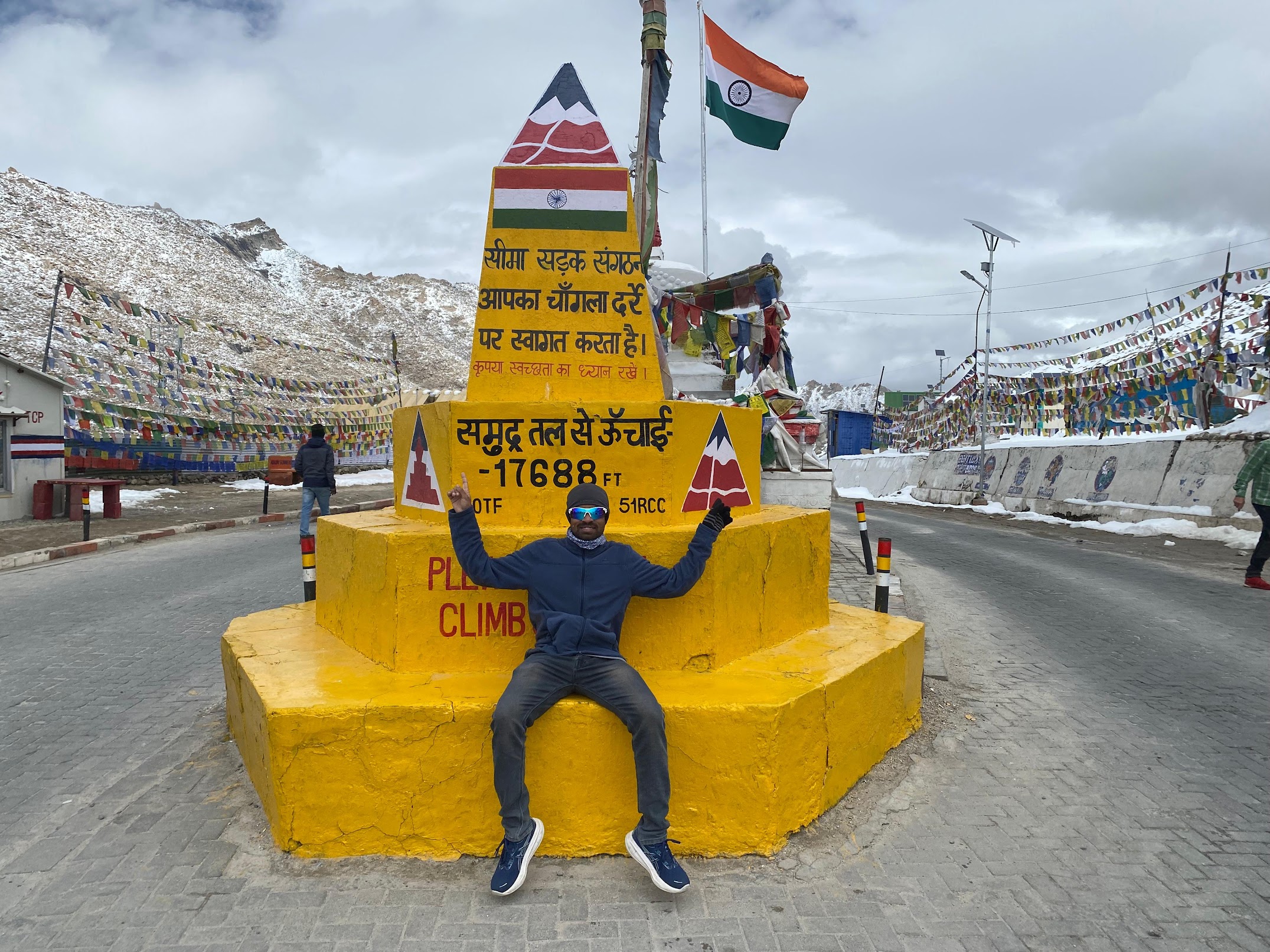
Our trip to Pangong Lake served dual purposes — sightseeing and acclimatization. The 150-kilometer journey took us to 14,270 feet, where the lake's impossible blue waters stretched against barren mountains like something from another planet. Spending time at this altitude helped our red blood cell production kick into gear.
On the return journey, we stopped at Chang La Pass (17,688 feet) for a 7-kilometer walk-run. This time, the altitude felt manageable. The gradual exposure to higher elevations was paying dividends — what had felt impossible a week earlier now felt challenging but doable.
Race Eve: The Calm Before
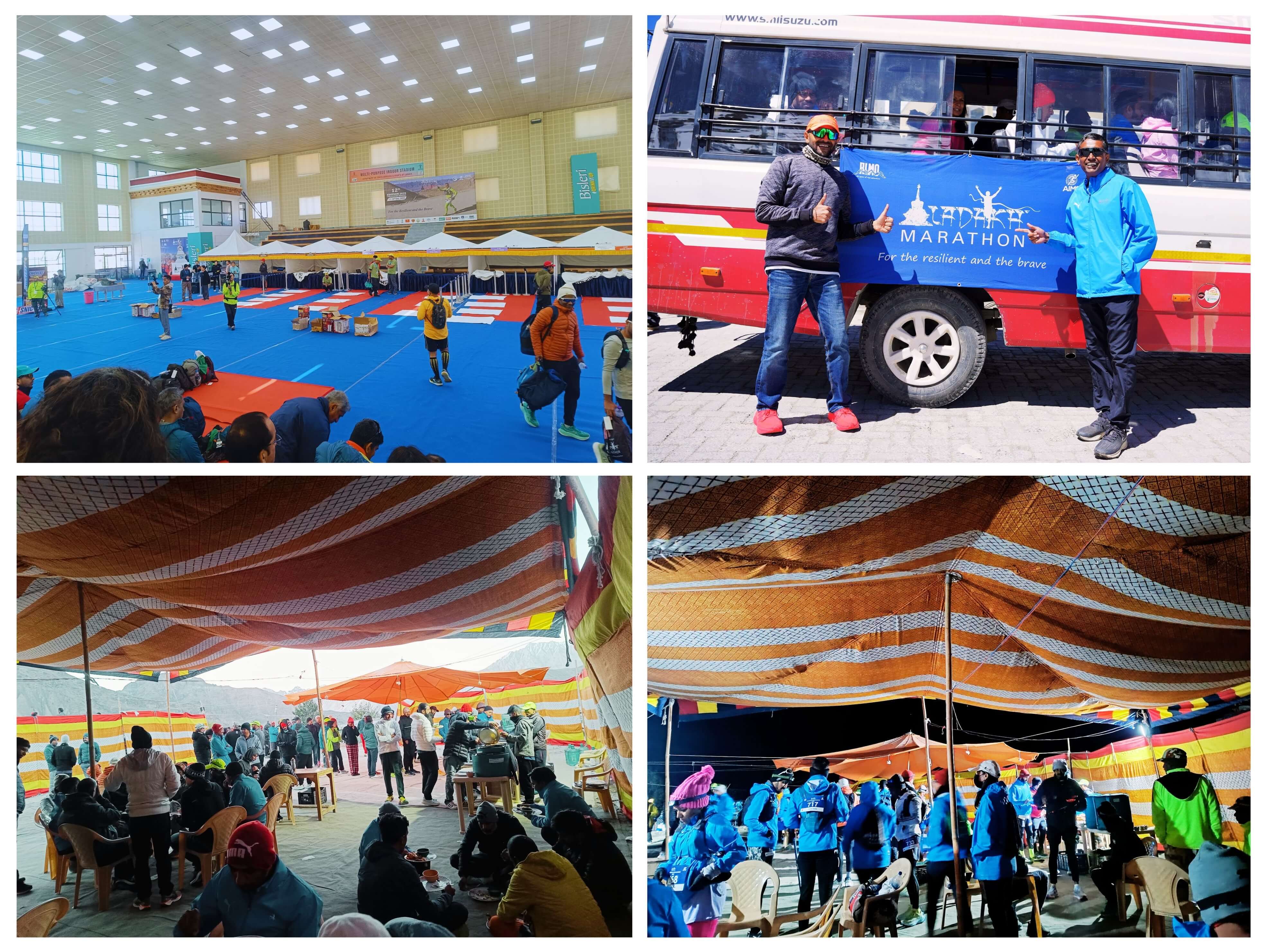
The final day began with a race briefing at NDS Memorial Stadium. Route details, checkpoint logistics, weather updates — the race director walked us through everything we needed to know. By 9:30 AM, we were Khardung village-bound.
The homestay check-in at 1 PM marked the beginning of the end of our preparation. Lunch, a gentle evening stroll, dinner by 6 PM, and lights out by 7 PM. I managed 2.5 hours of solid sleep before my 1 AM wake-up call.
At 3 AM, under a canopy of Himalayan stars, the Khardung La Challenge began. Interestingly, this was also the cut-off time for Silk Route Ultra runners completing their first 50 kilometers of a 122-kilometer journey. We cheered for those warriors who'd made it just in time, knowing we were about to embark on our own journey into the unknown.
Twelve days of careful preparation had brought us to this moment. Now it was time to discover what lay beyond the comfortable boundaries of low-altitude running.
Effective Acclimatization Tips for the Himalayan Ultramarathons:
Arrive early - 12+ days at altitude made a huge difference; don't rush this process
Start with complete rest - first 2-3 days should be about hydration and gentle walks only
Progress gradually - light jogs before proper runs; let your body adapt at its own pace
Do a demo run - test the actual race route if possible; learn pacing lessons before race day
Respect descent pacing - downhills at altitude are deceptively punishing; controlled speed is key
Seek higher altitudes - trips to places like Pangong Lake (14,270 ft) boost adaptation
Quality gear matters - proper thermals, jackets, and layers can make or break your race
Sleep well before race day - prioritize rest over nervous energy; your body needs recovery time
Part 3: Khardung La Challenge Race Day - A Detailed Report
Pre-Run Thoughts
Standing in the pre-dawn darkness at 13,000 feet, I felt a mix of excitement and anticipation unlike any race before. Confidence in my preparation mixed with curiosity about the unknown territory ahead. After months of training and twelve days of acclimatization, my body felt ready, but my mind was racing through every possible scenario.
The strategy was deceptively simple: reach Khardung La top (32 km) in ~5 hours, then descend to Leh over 40 km in ~4 hours. A finish between 9–10 hours seemed realistic on paper. But standing there in the thin air, surrounded by other runners who looked equally nervous and excited, I realized no amount of planning could prepare me for what was about to unfold.
0–17 Kms (Khardung Village → North Pullu)
⏱️ 02:14:14 | 🏃 7:46/km
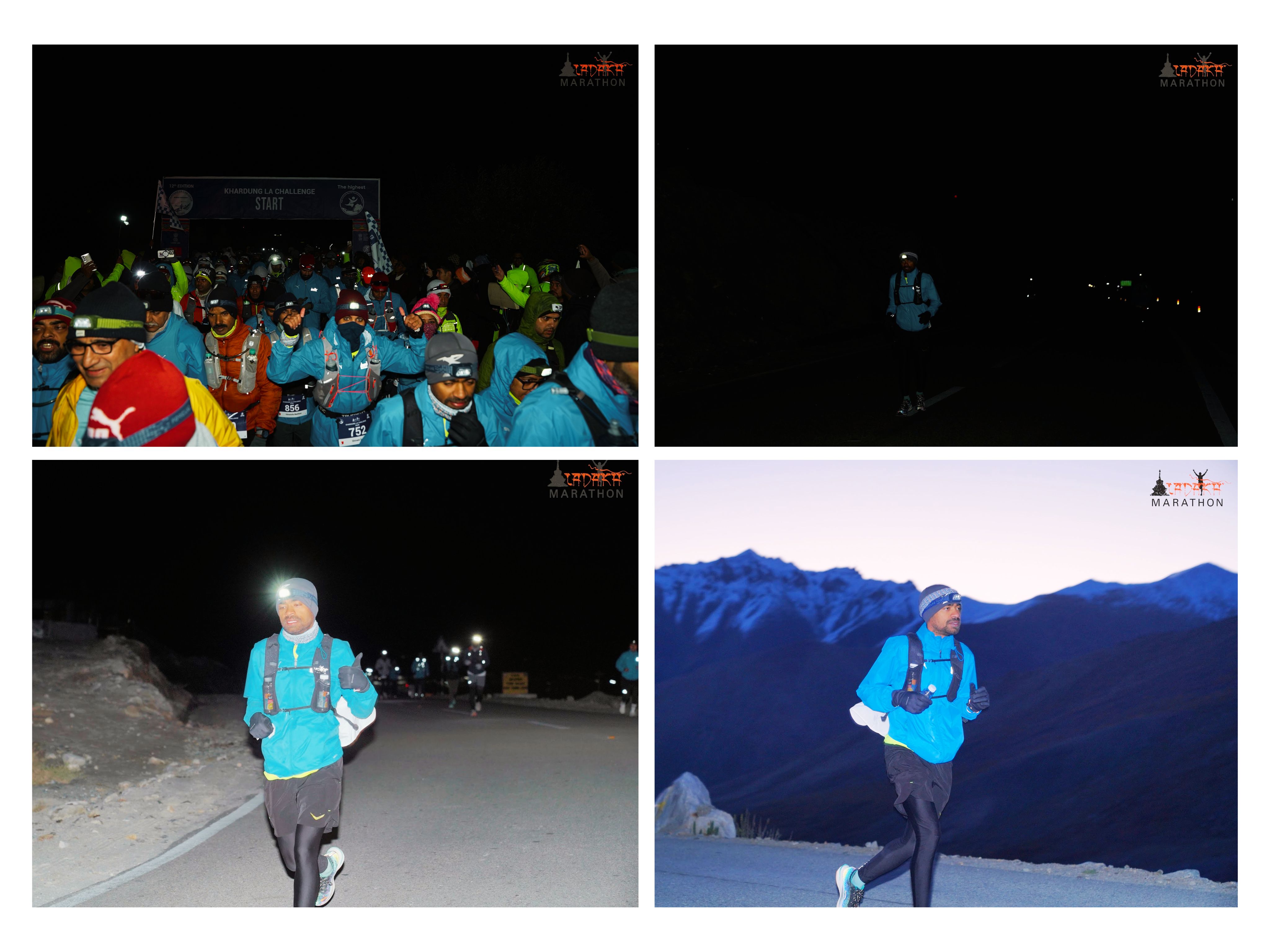
The first few kilometers surprised me with how good I felt. The nervous energy from the start line had transformed into pure excitement. The climb felt manageable, almost enjoyable, and being surrounded by other runners created an infectious energy that carried me forward.
A fellow Hyderabad runner and I fell into a comfortable rhythm — 40% walking, 60% running — checking in with each other about how we were feeling, monitoring our bodies' responses to the climb. The headlamps created a constellation of moving lights snaking up the mountain, and I felt confident about the journey ahead.
Gels: Fast&Up Chocolate Bourbon (0:00), Fast&Up Zesty Lemon (1:00).
18–32 Kms (North Pullu → Khardung La 🏔️)
⏱️ 02:42:07 | 🚶 10:41/km
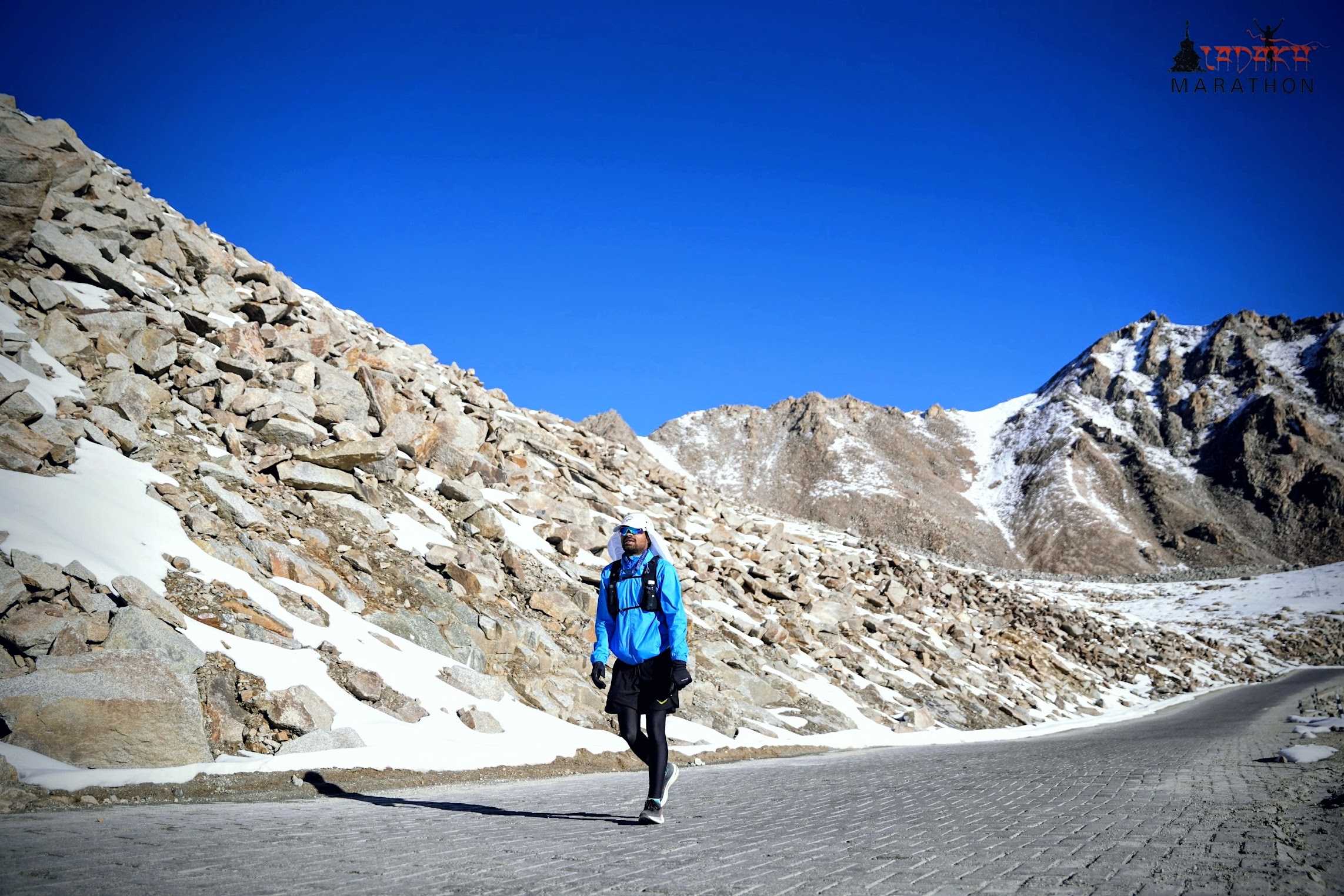
The altitude made its presence known. The early euphoria gave way to the steady challenge of thin air. Every step required more effort as my body adapted to the reduced oxygen. Even walking demanded focus, my lungs working harder to extract what they needed from the mountain air.
The last 6 kilometers to the top were tougher than expected. I aimed for a 10 min/km pace, but the altitude made even that challenging. Each breath required more effort, and I had to adjust my expectations about what was sustainable at this elevation.
But then, finally, the prayer flags of Khardung La Pass came into view.
Standing at 17,618 feet, I felt a rush of emotions I couldn't untangle — relief, pride, exhaustion, and a strange sense of being completely alive. I took 8 minutes to reset: shed the thermal top, switched to a dry-fit t-shirt with arm sleeves, layered my running jacket, and applied sunscreen. The lighter gear felt like shedding old skin. Halfway done, but the hardest part might still be ahead.
Gels: Unived Sea Salt Lime (2:30), Fast&Up Lime Lemon (4:00).
33–36 Kms (Initial Descent)
⏱️ 00:35:12 | 🏃 6:24/km
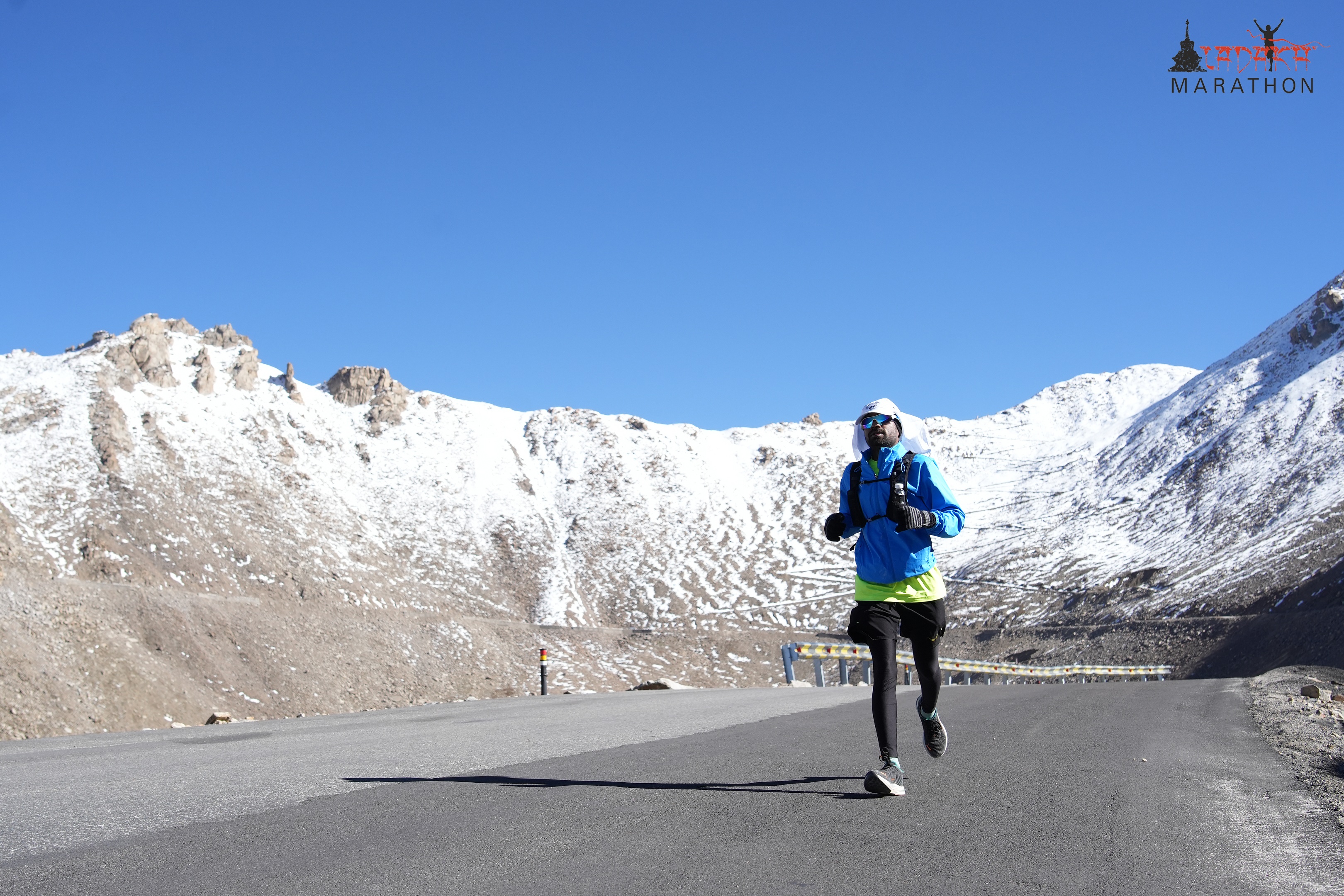
The descent brought immediate relief. After the grinding climb, gravity became my friend again, and I could finally run continuously. My legs felt fresh and eager after the forced walking pace of the ascent. The lesson from my demo run echoed in my mind though — respect the descent, don't let it seduce you into reckless speed. Icy patches kept me honest, demanding careful foot placement even as my body wanted to fly down the mountain.
For four glorious kilometers, I felt like I was back in my element.
37–47 Kms (towards South Pullu)
⏱️ 01:27:25 | 🏃 7:46/km
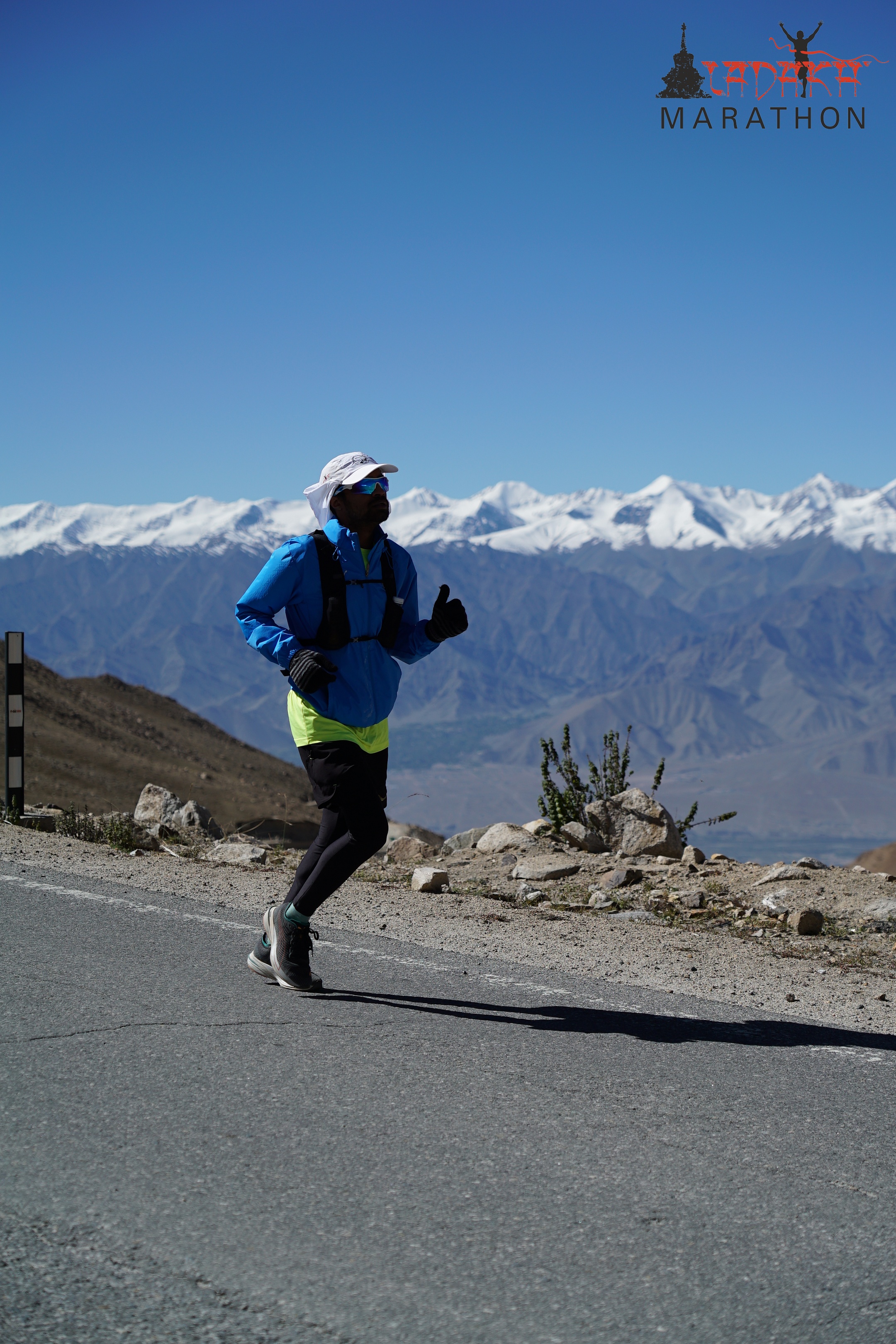
Then reality reasserted itself. The comfortable running rhythm I'd enjoyed for the past few kilometers began to falter. My breathing became labored again, forcing me back into the walk-run pattern I'd hoped to leave behind at the pass. The altitude was still very much in control, reminding me that this wasn't going to be as simple as running downhill to the finish. The isolation didn't help — long stretches with no other runners in sight, just me and the endless mountain landscape.
The loneliness was the hardest part. When another runner appeared, I'd latch onto their presence, running alongside them for precious minutes of shared suffering. But mostly it was just me, my labored breathing, and the growing realization that ultra-marathon running, especially at this altitude, was different from any marathon I had ever run. Not impossible, just... different.
48–58 Kms (South Pullu → Mendak Mor)
⏱️ 01:08:14 | 🏃 6:04/km
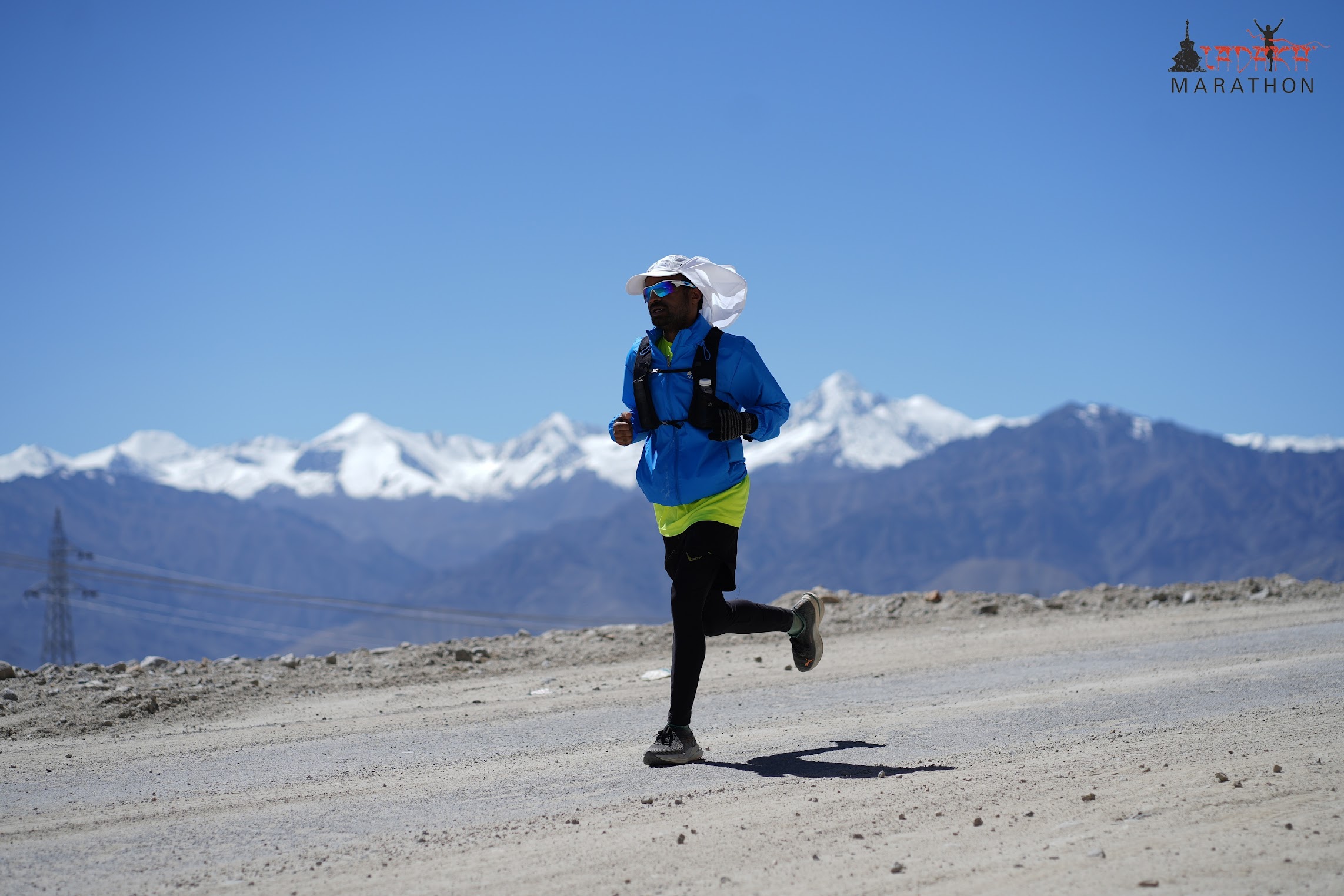
Finally, relief. As we dropped in elevation, my lungs remembered how to work properly. The roads were smooth and freshly constructed, and for the first time in hours, I could run with something approaching normal rhythm. My body felt like it was waking up from a long, oxygen-starved dream.
The company of other runners — including one incredible Silk Route Ultra warrior — brought back the energy I'd been missing. There's something magical about shared suffering that transforms individual struggle into collective triumph. My pace picked up naturally, and I found myself smiling for the first time since Khardung La Pass.
Gel: Unived Caramel Latte (7:00).
59–72 Kms (Mendak Mor → Leh)
⏱️ 01:18:08 | 🏃 5:31/km
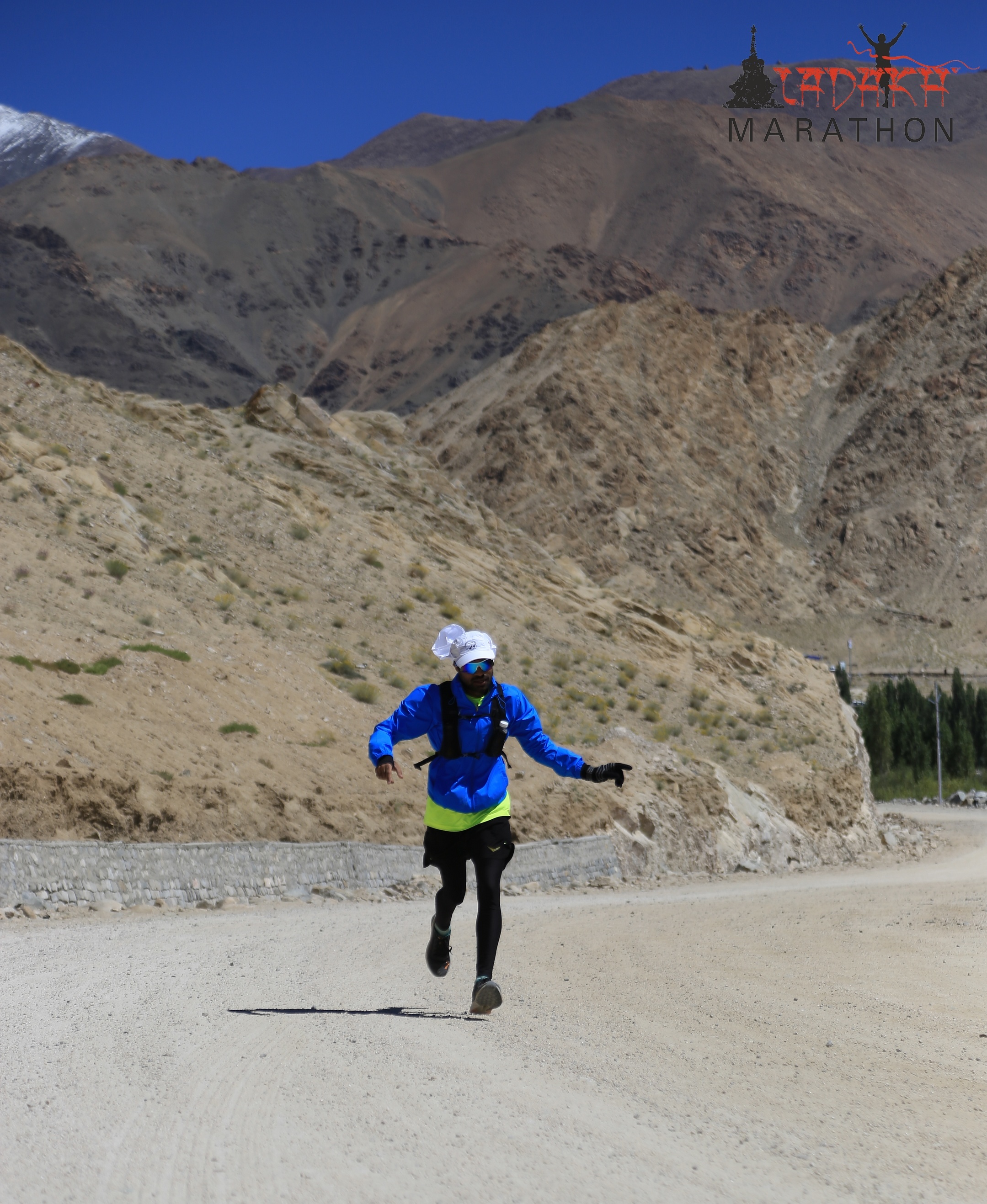
The final stretch became a solo journey home. My legs had found their rhythm, and despite some dusty patches, I was moving faster than I had all day. When the outskirts of Leh appeared with 5 kilometers to go, a surge of emotion hit me — I was actually going to finish this thing.
The uphill sections still demanded respect, forcing me to dial back the pace, but the crowd's cheering became my fuel. Every voice of encouragement felt personal, like the entire city was willing me toward the finish line.
I encountered a brief scare at 69 km when my left hamstring tightened, but the SAG support was incredible — a quick spray and the issue vanished. As I approached the final stretch, the cheering crescendoed into something electric. The last 100 meters felt like running through a tunnel of pure energy, every face in the crowd beaming with shared joy.
Crossing that finish line after 9 hours and 27 minutes brought a deep satisfaction — completing my first ultra-marathon exactly as I'd hoped. I'd been confident I could finish, but curious about what it would actually feel like to push beyond the marathon distance. Now I knew, and I'd finished strong just as I'd wanted.
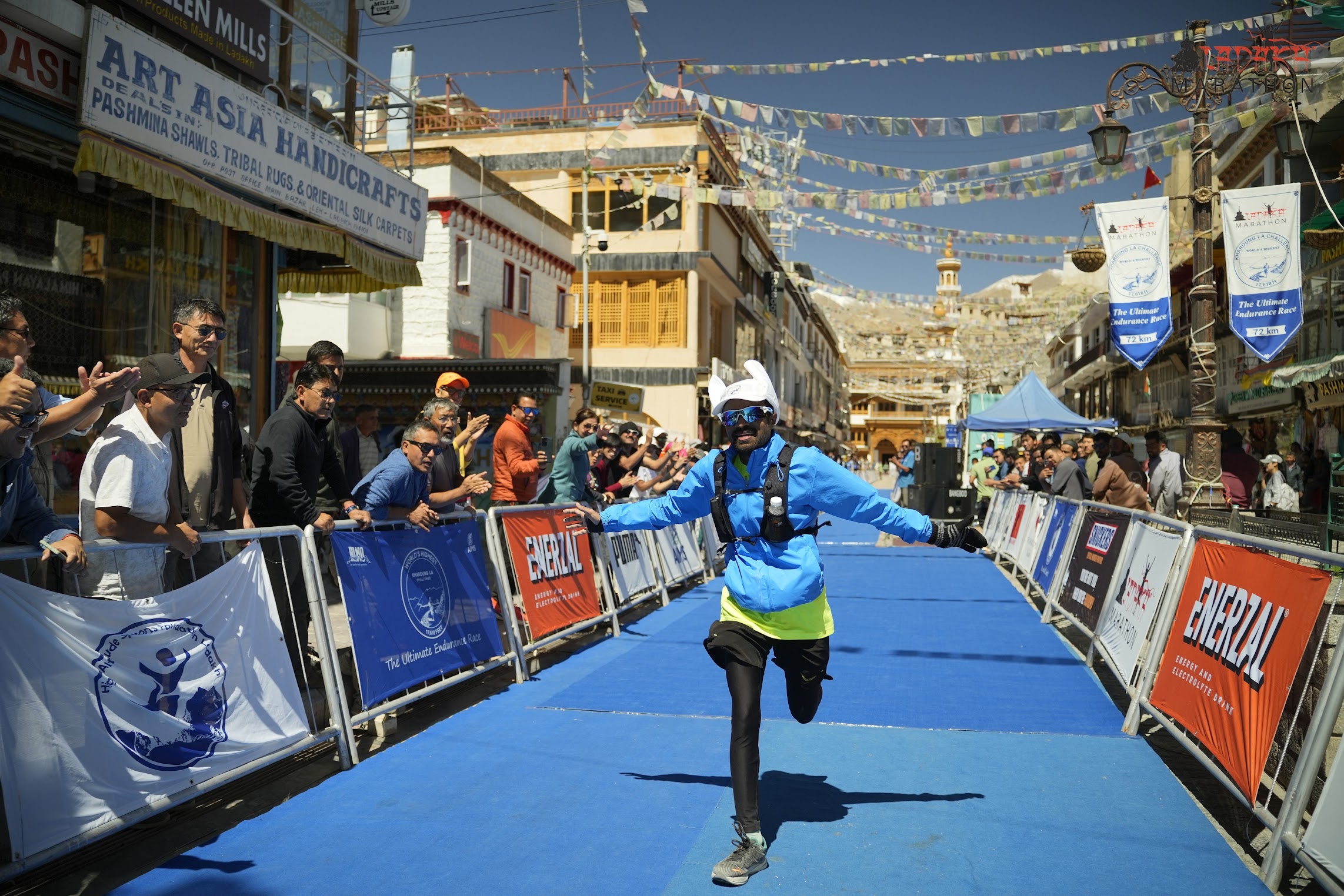
✨ Finish: 09:27 hrs | Avg Pace: 7:37/km
Key Race Day Tips That Worked:
Start conservatively - first 17km felt easier than expected; save energy for the altitude challenge ahead
Use a buddy system early - running with a fellow Hyderabad runner helped maintain good pacing and morale
Adjust expectations at altitude - when breathing gets tough, focus on forward progress rather than pace targets
Take time at the summit - 8 minutes to change gear and reset at Khardung La Pass was time well invested
Respect the descent lessons - apply demo run learnings; controlled pacing prevents altitude sickness
Embrace company when available - other runners provide energy and motivation during tough stretches
Use SAG stations strategically - refuel regularly and don't hesitate to address issues (like hamstring tightness) immediately
Feed off crowd energy - let the cheering in Leh carry you through the final kilometers
Stick to your nutrition plan - regular gel timing and SAG station variety kept energy levels stable
Finish strong mentality - maintain confidence in your preparation and push through the final stretch
Part 4: Final Reflections on My First Ultra-Marathon
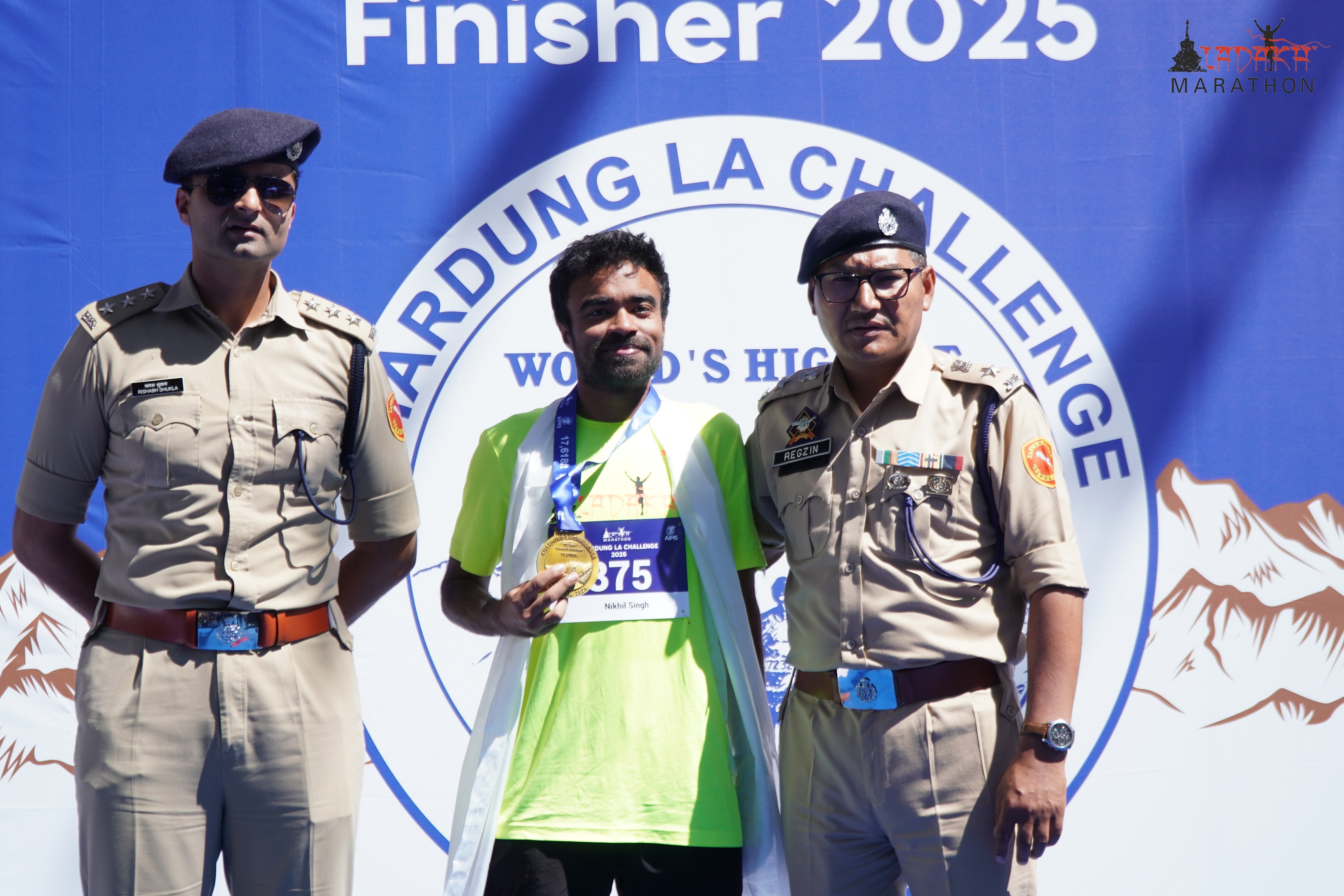
The Infrastructure That Made It Possible
The Ladakh Marathon team deserves immense credit for creating an infrastructure that turned an extreme challenge into a manageable adventure. SAG stations appeared like mirages every 5 kilometers, each one a perfectly orchestrated oasis of support. The staff didn't just hand you supplies — they cheered, they encouraged, they made you feel like every step mattered.
My nutrition strategy became a delightful tour of local and familiar flavors: Peanut Chikki for quick energy, dates for natural sweetness, the surprising comfort of warm Garlic Soup at high altitude, the sharp clarity of Lemon + Salt, the familiar boost of a Snickers Bar, and the refreshing burst of Mandarin and Watermelon. Each SAG station offered choices, and my body seemed to know exactly what it craved at each moment.
What Ultra-Marathon Running Teaches You
Ultra-marathons operate in a completely different universe from regular marathons. Where a marathon tests your speed and endurance, an ultra tests your relationship with discomfort, your ability to problem-solve on the move, and your capacity to keep moving when every rational part of your brain suggests stopping.
The most surprising discovery? My body's incredible adaptability. After 9+ hours of continuous movement at altitude, I crossed the finish line with no upset stomach, no injuries, no blisters, no headaches — just a profound sense of having discovered something new about what's possible. The human body, when properly prepared and respectfully pushed, reveals reserves of strength that lie dormant in our everyday lives.
The Addiction Begins
There's something intoxicating about the ultra-marathon experience that regular running can't replicate. It's not masochism — it's the deep satisfaction of sustained effort, the meditative quality of hours spent in forward motion, the way problems simplify when your only job is to keep moving toward a distant finish line.
I'm already planning my next ultra adventures — 1-2 per year feels like the right rhythm to explore this new territory without losing the magic. Each one will be different, each will teach something new about the intersection of preparation, determination, and the surprising resilience we all carry within us.
The Khardung La Challenge wasn't just my first ultra-marathon; it was my introduction to a new way of understanding what the human body and spirit can accomplish when they work together toward something that once seemed impossible.
